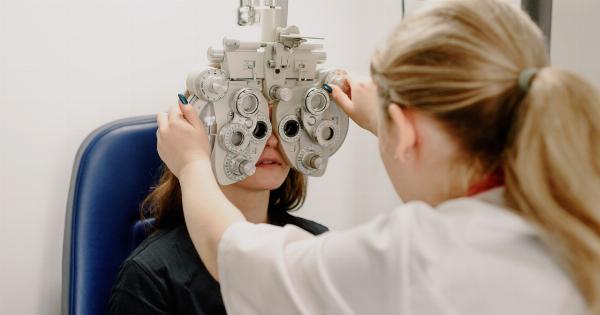Vision is a vital sense that we rely on for almost everything we do. Our eyes are the window to the world, and they allow us to see the people, objects, and the beauty of nature that surround us.
However, vision problems are common, and they often go unnoticed until they cause significant damage. In many cases, the signs of vision loss are subtle, and people don’t seek help until it’s too late.
What is Vision Loss?
Vision loss is a condition that affects a person’s eyes, causing blurred or distorted vision, partial or total blindness, or the inability to see colors.
It can be caused by various factors, including injury, genetic predisposition, and diseases such as diabetes and glaucoma. Although vision loss can happen at any age, it is more common among older adults.
According to the World Health Organization, approximately 285 million people worldwide suffer from some form of visual impairment, with 39 million cases being completely blind.
The Subtle Signs of Vision Loss
Many people believe that vision loss involves sudden blindness or going from perfect vision to seeing nothing but darkness. However, most cases of vision loss are much more subtle than that.
Here are some of the top subtle signs that your vision may be deteriorating:.
Squinting
If you find yourself squinting or straining your eyes to see objects that were previously easy to read or see, it may be a sign of vision loss.
Squinting is a way of trying to sharpen the focus of the eye, and it often happens in people with nearsightedness or farsightedness. However, if you find that squinting no longer helps improve your vision, or you need to squint more often than before, you should get your eyes checked.
Halos or Blurred Vision
If you notice halos or glare around lights or have blurry vision, it could be an indication of cataracts, an eye condition that is characterized by a cloudy or opaque lens.
Other signs of cataracts include colors appearing faded or yellowed, sensitivity to light, and double vision. Cataracts are a common condition, and they can usually be corrected with a simple surgery. However, if left untreated, they can lead to significant vision loss.
Difficulty Seeing at Night
If you find that driving at night has become more difficult, or you’re having trouble seeing in low light conditions, it may be a sign of night blindness.
Night blindness is a condition in which the eyes cannot adapt to low light conditions, making it hard to see at night or in the dark. The condition may be caused by myopia, cataracts, or other eye problems and may be corrected with prescription glasses, surgery, or other treatments.
Frequent Headaches or Eye Fatigue
If you often experience headaches or eye strain after reading, watching TV, or using a computer, it may be a sign that your eyes are working harder than they should.
Eye fatigue is a common condition caused by prolonged use of screens or other visual tasks that require prolonged concentration. If the condition persists, it can lead to more severe problems, such as double vision or blurred vision.
Red or Dry Eyes
Red, sore and dry eyes can also be a sign of vision loss. Dry eye syndrome is a condition that occurs when the eyes don’t produce enough tears, or the quality of the tears is poor.
The symptoms include itchiness, redness, and a burning sensation in the eyes. Dry eye syndrome is often a result of aging and can be corrected with eye drops. However, in severe cases, the condition can lead to vision loss and should be treated by an eye specialist.
Sudden Appearance of Floaters or Flashes of Light
If you suddenly see floaters or flashes of light, particularly in one eye, it could be an indication of retinal detachment, a very serious eye condition that requires immediate treatment.
Retinal detachment is a condition in which the retina, the layer of tissue at the back of the eye, detaches from the surrounding tissue. The condition can lead to permanent vision loss and requires immediate surgical treatment to prevent further damage.
Tunnel Vision
If you experience a loss of peripheral vision, or you feel like you’re looking through a tunnel, it could be a sign of glaucoma. Glaucoma is a group of eye diseases that cause damage to the optic nerve, leading to a gradual loss of vision.
The condition is usually accompanied by eye pain, headaches, and nausea, and should be treated immediately to prevent further damage to the eye.
Distorted Vision
If you notice that straight lines appear wavy or bent, or that objects appear distorted, it could be a sign of macular degeneration.
Macular degeneration is a common eye condition that affects the macula, the part of the eye responsible for central vision. The condition may cause blurred or distorted vision, gaps or dark areas in the center of the vision, or a change in color perception.
Fading Color Vision
If you notice that colors appear less vibrant or that you can no longer distinguish between certain colors, it could be a sign of color vision deficiency, a condition that affects the way people perceive colors.
The condition is usually genetic, and it affects more men than women. Although color vision deficiency is not dangerous, it can affect a person’s quality of life and their ability to perform certain tasks, such as reading traffic lights or selecting clothing.
Bump into Objects
If you find yourself bumping into objects or misjudging distances, it could be a sign of vision loss. Depth perception is an important visual skill that allows us to judge distances and see the world in three dimensions.
If the eyes are not working together properly or if there’s a problem with the lens, it can affect depth perception and cause bumps and falls.
Conclusion
Vision loss can be extremely debilitating, affecting a person’s quality of life and independence. However, the good news is that early detection and treatment can help prevent further damage and reduce the risk of severe vision loss.
If you notice any of the above subtle signs of vision loss, it’s essential to get your eyes checked by an eye specialist as soon as possible.


























